|
|
|
Sort Order |
|
|
|
Items / Page
|
|
|
|
|
|
|
| Srl | Item |
| 1 |
ID:
178297


|
|
|
|
|
| Summary/Abstract |
In May–June 1969, David Ben-Gurion set out on his last trip abroad. Ben-Gurion, eighty-two years old, was aware of his situation and knew what the ravages of time had done to his ability to function. Still, he felt physically fit enough for one last effort. Thus, he spent five weeks visiting Jewish communities on three continents – his longest stay outside Israel since the country had been founded. The worldview that undergirded the journey and lent them purpose and meaning within the whole of Ben-Gurion’s outlook on the Jewish and Israeli reality sheds multifaceted light on the leader in his dotage.
|
|
|
|
|
|
|
|
|
|
|
|
|
|
|
|
| 2 |
ID:
178304
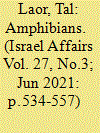

|
|
|
|
|
| Summary/Abstract |
Digital platforms have become a major tool for media figures. The Internet offers the media essential tools, most notably authentic and accessible sources of information and the absence of censorship. Digital media provides media personalities with a platform that is free and fast where they can express themselves freely without ‘gatekeepers.’ Drawing on Deuze’s five-dimensional model of journalism, this article shows that for the content transfer platform, the network is characterised by a young audience, leading to more consumer confidence due to its authentic nature. It also found that platform selection relates directly to content and that media people use the network to promote agendas. In addition, their influence on social networks is greater because they are bi-directional and allow for audience reaction. As for the media figure’s personality, it was found that the success of media figures does not involve the quality of the content but the admiration of the audience. In addition, it emerged from the interviews that technological determinism affects media figure activities such that ‘the medium is the message’ – type of media dictates choice of the content transfer platform, content, and media figure personality.
|
|
|
|
|
|
|
|
|
|
|
|
|
|
|
|
| 3 |
ID:
178308


|
|
|
|
|
| Summary/Abstract |
The Israeli Moshavim were agricultural cooperative associations grouped into regional procurement associations, operated under a mechanism of joint liability lending until the 1985 debt-crisis. Unique historical financial-panel-data offers behavioural insights into the joint liability group lending, through constructing Moshavim’s Debt-To-Output (DTO) ratio distribution. The right-tailed exponential distribution captures the finding that a small portion of the Moshavim were debtors. A semi-parametric model synthesises between the debtors and the creditors. While a joint liability mechanism might boost risk-receptiveness and excessive optimism concerning the peer’s accountability for some, it carries a reversed effect for others. Thus, the failure of the mechanism might be unavoidable.
|
|
|
|
|
|
|
|
|
|
|
|
|
|
|
|
| 4 |
ID:
178299
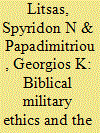

|
|
|
|
|
| Summary/Abstract |
The deployment of special forces in hostile or politically volatile environments in search of strategic/operational intelligence, though not a 21st century novelty, appeared as a distinct military activity in literature only in the early 2000s under the label ‘Special Reconnaissance’ (SR). This article argues that the concept of SR (a) originated in the biblical Israelite military tradition and is depicted in the Bible as the lapis angularis of military strategy and a practice capable of dictating military and political norms; (b) has been used as a key element of the Israel Defence Forces’ (IDF) modus operandi since 1948 thenceforth functioning in an analogous manner. To support these arguments, the theoretical and practical characteristics of Moses’ intelligence mission to Canaan as well as the IDF’s proclivity to SR are scrutinised under the general theoretical framework of political realism that assumes rational and pro-state interest course of actions. Accordingly, SR emerges as a distinctive common instrument of biblical and contemporary Israeli strategy, a fact that underlines the uninterrupted socio-political and cultural links between the past and the present of the Israeli ontology, this time via the wider concept of the Israeli military ethics.
|
|
|
|
|
|
|
|
|
|
|
|
|
|
|
|
| 5 |
ID:
178301
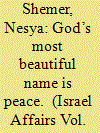

|
|
|
|
|
| Summary/Abstract |
Rabbi Menachem Froman was a foremost religious peace activist who sought to promote Israeli-Palestinian reconciliation through conversations with religious leaders of the two peoples and discussions with politicians in Israel and the world. This article examines his vision of inter-religious peace and his attempts to realise this vision, using archival materials revealed after his death in 2013 as well as his previously published philosophical musings and writings.
|
|
|
|
|
|
|
|
|
|
|
|
|
|
|
|
| 6 |
ID:
178318
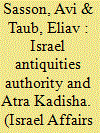

|
|
|
|
|
| Summary/Abstract |
Atra Kadisha is an ultra-Orthodox organisation that is at the forefront of the battle against excavation of ancient graves for fear of desecrating the dignity of the dead. This article examines the interrelationship between the organisation and the relevant state authorities, notably the Israel Antiquities Authority (IAA), in an attempt to ascertain the extent of bureaucratic rigidity/flexibility in Israel on the issue of excavating ancient graves, and to assess implications of this behaviour for the public space.
|
|
|
|
|
|
|
|
|
|
|
|
|
|
|
|
| 7 |
ID:
178316


|
|
|
|
|
| Summary/Abstract |
Social Work as a profession plays a fundamental role in the development of the state, especially in assisting the most vulnerable parts of the population by way of contributing to the building of a fairer society and collective solidarity. Social work in Israel finds its professional space in several diverse fields with social work professionals using a wide variety of methodologies with individuals, groups and communities. This article discusses the evolution of the social work profession since Israel’s establishment in 1948, the welfare perspective that evolved over the years, and the vicissitudes in its underlying social values and ethical codes.
|
|
|
|
|
|
|
|
|
|
|
|
|
|
|
|
| 8 |
ID:
178296
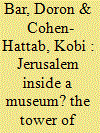

|
|
|
|
|
| Summary/Abstract |
In 1989, The Jerusalem Citadel (or Tower of David) was inaugurated as the Museum of the History of Jerusalem. The museum’s establishment stretched over two decades, highlighting the different dilemmas that were tied to the State of Israel’s attitude towards Jerusalem generally and the Old City in particular. The museum displayed Jerusalem using a historical-chronological approach, avoiding adapting it to the city’s multicultural, vibrant, diverse, and multihued society after the Six-Day War. This spared and precluded the possibility of focusing on the city’s many dilemmas, its complex population and the city’s many political questions and schisms following 1967.
|
|
|
|
|
|
|
|
|
|
|
|
|
|
|
|
| 9 |
ID:
178298
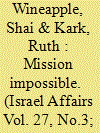

|
|
|
|
|
| Summary/Abstract |
Using primary archival and other contemporary sources, this article explores the relationship between the Christian mission and Israel as a modern Jewish nation-state from its establishment in 1948 until 1965, when section 13a of the Legal Capacity and Guardianship Law, 5722–1962, was enacted in the Israeli Parliament (Knesset). Since the rebirth of the State of Israel, a number of Christian Protestant Churches and missionary organisations have worked to convert Jews to Christianity. The State of Israel opposed such proselytising yet wished to maintain its commitment to freedom of religion as stated in its Declaration of Independence. Furthermore, it did not wish to damage foreign relations with the Christian world.
|
|
|
|
|
|
|
|
|
|
|
|
|
|
|
|
| 10 |
ID:
178300
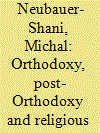

|
|
|
|
|
| Summary/Abstract |
Gender equality in the synagogue space gained momentum and engendered a discourse among religious feminist women in recent decades. In Israel this was accompanied by the harbingers of separate women’s gatherings for prayers and supplication among women of varied backgrounds. This gave rise to the notion of feminine thought in the world of Jewish prayer as opposed to a precise facsimile of men’s prayer. The article focuses on the ‘Shirat Rivka’ prayer group in the Neve-Daniel locality (Gush-Etzion) as a unique case study in this context. It examines the group’s characteristics as a manifestation of Post-Orthodoxy and Orthodox Feminism and offers a new prototype of women’s prayer that enables Orthodox women who do not necessarily view themselves as part of the feminist revolution to be active in this sphere.
|
|
|
|
|
|
|
|
|
|
|
|
|
|
|
|
| 11 |
ID:
178312
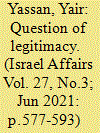

|
|
|
|
|
| Summary/Abstract |
Many members of minority groups clash violently with state agents. The case of West Bank rightwing activists is particularly paradoxical. Unlike disempowered groups whose ability to bring about change is limited, these activists constitute a powerful sociopolitical force, and the security forces with which they clash also protect them in the territories to which they claim sovereignty. Based on 20 interviews with rightwing protest activists, this article explores what interpretation activists give to their part in violent clashes. The article offers two main contributions. First, it proposes the concept of perceived state legitimacy as a theoretical construct for evaluating the degree to which citizens view their state as legitimate. Unlike previous studies that define legitimacy as a unidimensional construct, perceived state legitimacy is defined here as made up of five different components: identification, trust, distributive justice, procedural justice, and legality. Second, the article shows empirically that violent clashes can indicate undermining distinct components of state legitimacy. Thus, West Bank rightwing activists who took part in violent clashes with state agents undermine the state’s legitimacy components of trust, distributive justice, procedural justice, and legality – but not identification.
|
|
|
|
|
|
|
|
|
|
|
|
|
|
|
|
| 12 |
ID:
178302
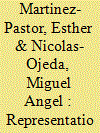

|
|
|
|
|
| Summary/Abstract |
This article offers a comparative overview of the representation of children and families in TV toy advertisements in Israel, Britain and Spain. It focuses on identifying the similarities and differences between the ads tasked with representing children in relation to specific products in different cultural environments. To a lesser extent, the article contributes, through its data, to exploring how advertisements adapt to each of the social and cultural realities in countries with different cultures.
|
|
|
|
|
|
|
|
|
|
|
|
|
|
|
|
|
|
|
|
|